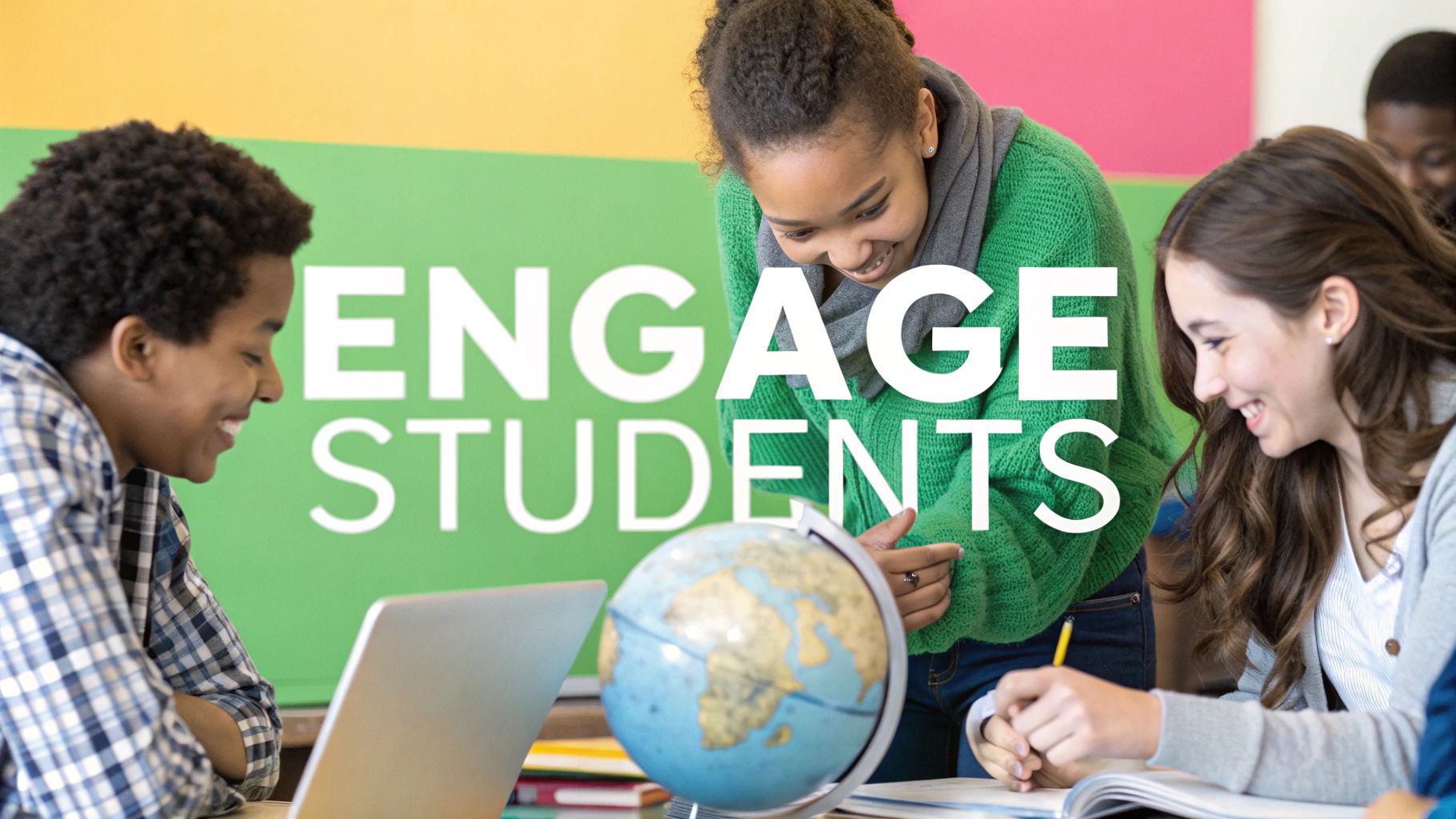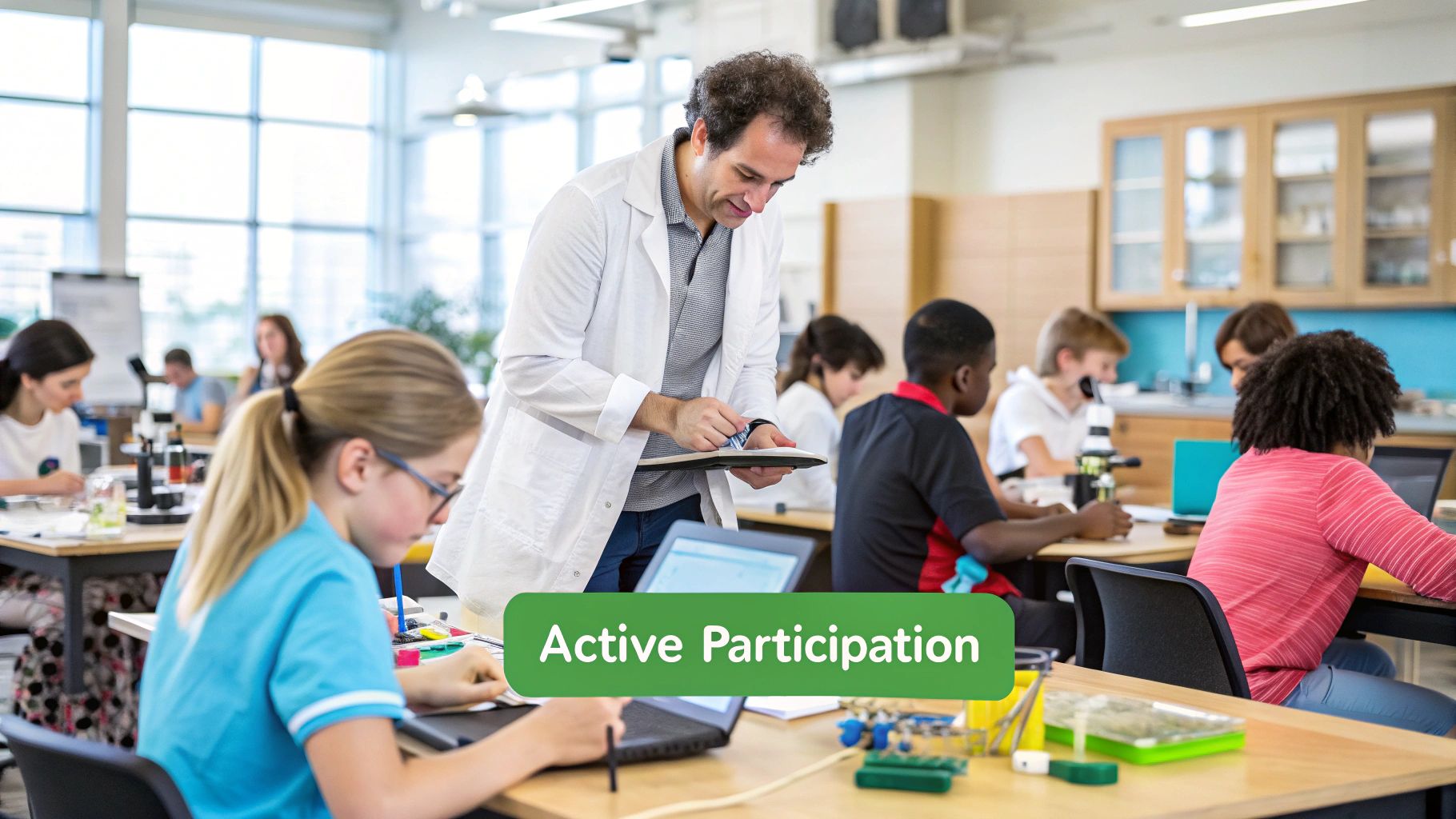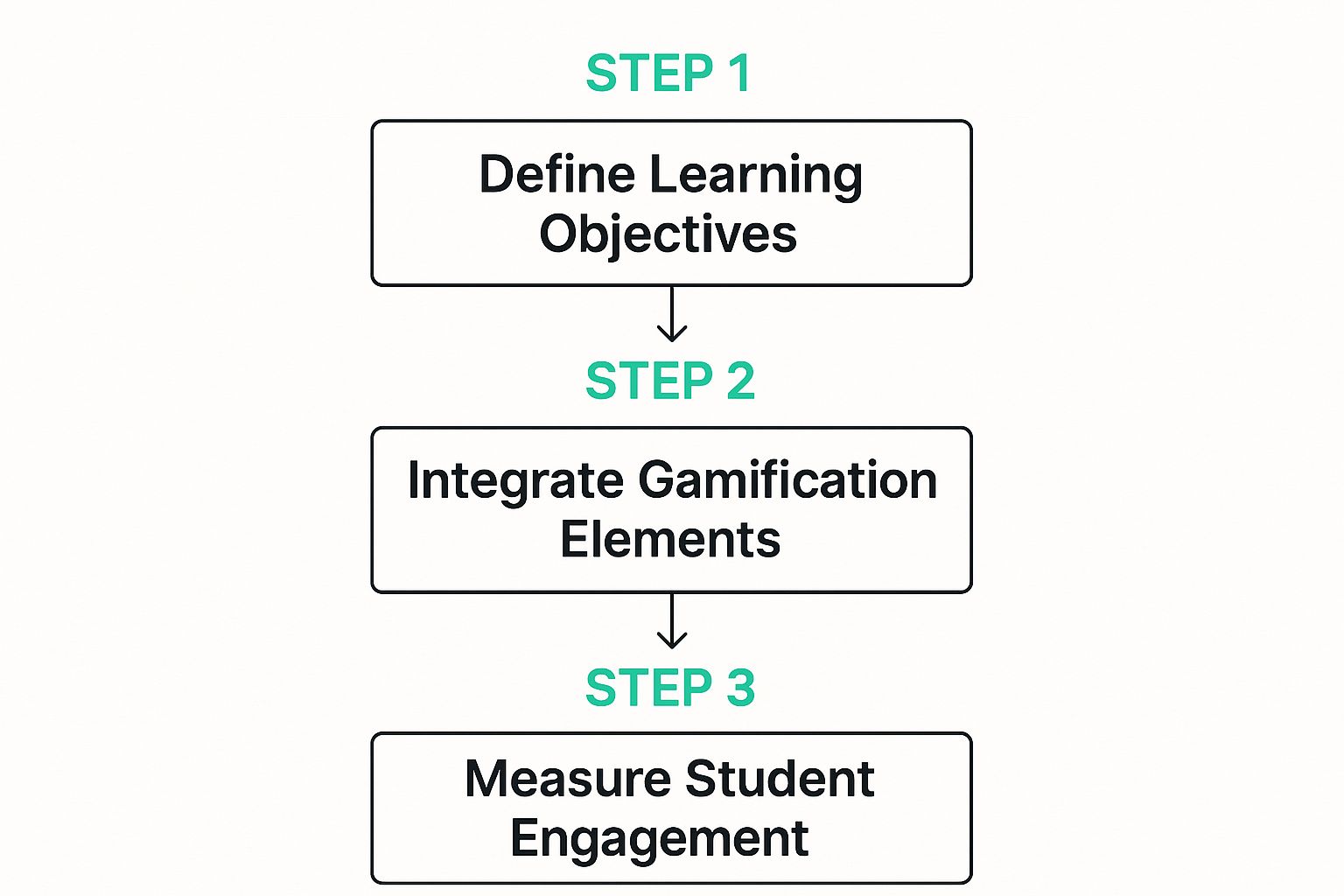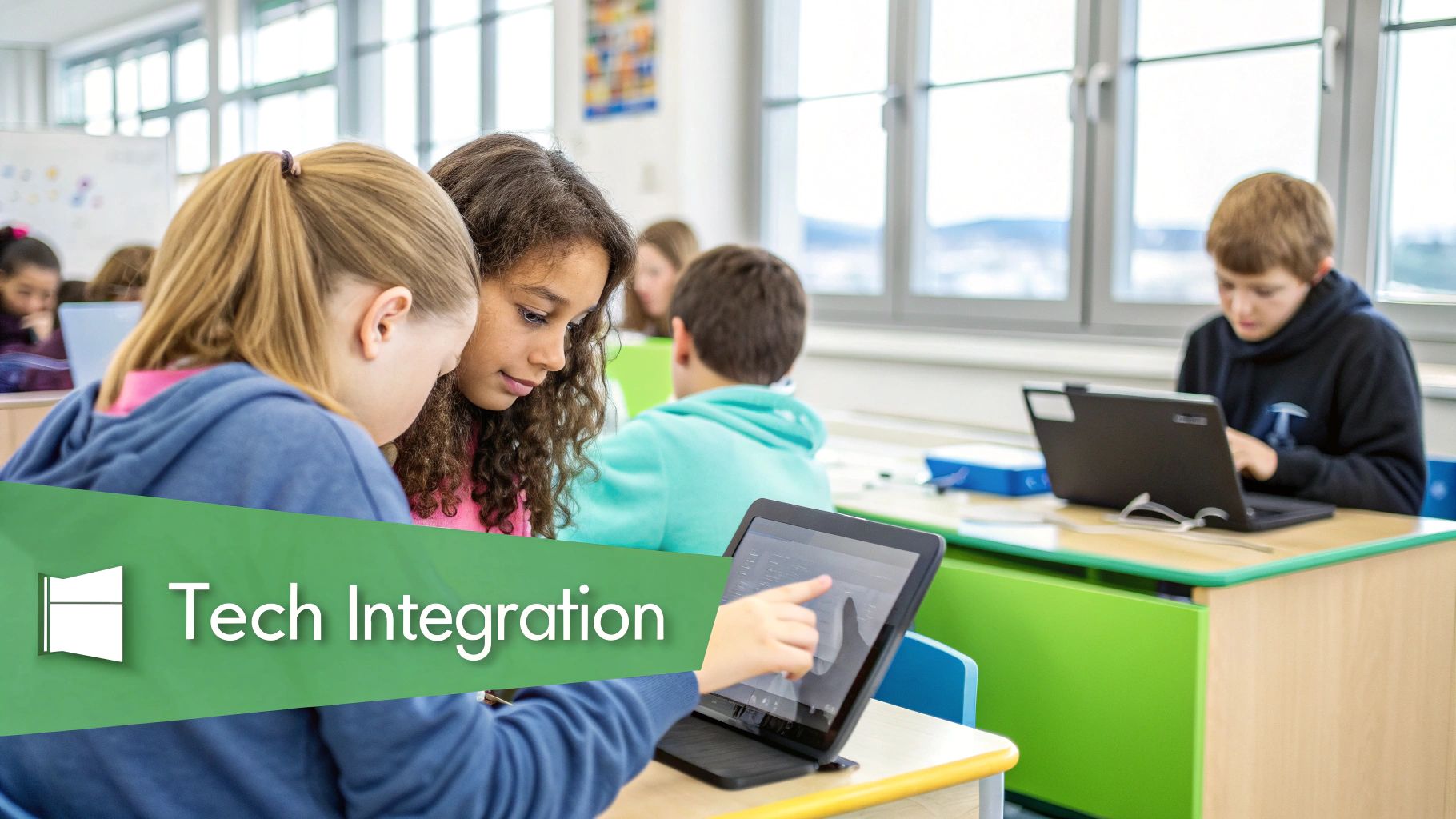How to Engage Students in Learning: Proven Teaching Strategies
Discover effective ways on how to engage students in learning and boost classroom participation with practical tips and innovative methods.

Knowing how to engage students in learning isn't about finding some magic formula. It really just comes down to making a shift—moving away from one-way lectures and toward active, hands-on participation.
The goal is to create an environment where learners aren't just listening. They're doing, exploring, and connecting what they learn to the world around them.
Rethinking Student Engagement In Today's Classroom

Let's be real for a second. Grabbing—and keeping—a student's attention can feel like a constant struggle. The old-school model of a teacher talking while students dutifully take notes is losing its punch. Today's learners have grown up with dynamic, on-demand content, which makes just sitting and listening a pretty tough sell.
But this isn't about blaming technology or shrinking attention spans. It’s a chance to look at the cognitive science behind why students tune out. What we as educators might think is super engaging, like a perfectly structured lecture, often doesn't line up with what actually sparks a student's desire to learn. Rote memorization and endless drills just don’t light that fire of genuine curiosity.
The Perception Gap in Engagement
Here’s something I’ve seen time and time again: a major disconnect between how engaged students think they are versus how engaged their teachers perceive them to be. This isn't just a minor difference in opinion; it's a critical signal that our old strategies might be missing the mark.
A pretty revealing study from Discovery Education put a number on this gap. While 63% of students reported feeling highly engaged, only 45% of teachers and 51% of principals saw it that way. That’s a huge difference, and it shows just how hard it is to define and measure something so vital for success.
The real objective isn't just keeping students busy. It's about fostering an environment where they're intellectually invested—where they're actively wrestling with ideas and building their own understanding.
Why A Strategic Shift Is Essential
Frankly, sticking to outdated teaching methods is no longer an option. For knowledge to actually stick, students have to be active players in their own education. This means we need to embrace methods that fuel critical thinking, problem-solving, and teamwork.
The payoff for making this shift is huge and directly impacts learning outcomes:
- Better Retention: When students are actively involved, concepts are more likely to move into long-term memory.
- Deeper Understanding: They go beyond just memorizing facts and start to truly grasp complex ideas.
- More Motivation: Learning becomes relevant and interactive, which naturally drives students to participate.
Getting this foundational need for a strategic shift is the first step. Before we get into the nuts and bolts of specific techniques, it helps to understand what makes learning truly interactive. For a deeper dive, check out our guide on what is interactive learning.
Creating a Culture of Active Participation

Real, genuine student engagement isn't something you can just wish into existence. It grows in a classroom built on a foundation of trust.
When learners feel seen, heard, and safe enough to take a few risks, they stop being passive listeners and start becoming active participants. But getting there takes more than good intentions. It requires a deliberate strategy to invite every single student into the conversation.
It all starts with what researchers call psychological safety. In plain terms, it's the shared belief that the classroom is a safe space to be human. Students know that asking a "silly" question or getting an answer wrong won’t lead to eye-rolls or embarrassment.
Move Beyond Passive Learning
The old-school lecture format often turns students into simple information sponges. To get them truly involved, we have to flip that dynamic on its head.
Simple, structured activities can completely change the energy in a room, pushing students to think and process information together.
One of the most reliable methods I’ve used is the think-pair-share technique. It’s a simple three-step process that works wonders in any class size:
- Think: Pose a thought-provoking, open-ended question. Then, give everyone a full minute of silent time to just gather their thoughts. No talking.
- Pair: Ask students to turn to a neighbor and discuss their ideas. This is a low-stakes interaction that builds incredible confidence.
- Share: Finally, invite a few pairs to share their combined insights with the whole class.
This structure guarantees that everyone has a chance to form an opinion before speaking out loud, which is a game-changer for more introverted learners.
A classroom where mistakes are framed as learning opportunities is everything. When students see errors as a normal, expected part of the process, they become so much more willing to raise their hands and share their real thoughts.
Empower Every Voice with Technology
Let's be honest: not every student is comfortable speaking up in front of the whole class. Shyness, language barriers, or just a simple fear of judgment can hold them back.
This is where technology can become your best friend in creating a more inclusive and participatory classroom.
Anonymous digital polls or Q&A platforms give quieter students a voice without putting them on the spot. They can submit questions or responses through a device, letting them engage with the material without the pressure of the spotlight. It's an amazing way to get a real-time pulse on understanding and uncover those hidden misconceptions you might otherwise miss. Exploring different educational technology tools for teachers can open up a world of new possibilities for getting everyone involved.
Refine Your Questioning and Physical Space
The way you ask questions can totally change the level of engagement. Instead of fishing for a single right answer, try posing questions that invite different perspectives.
Think about the difference between "What is the capital of France?" and "What are some different ways we could approach this problem?" or "What do you find most confusing about this topic?" The latter questions open the door for real discussion.
Even the layout of your classroom sends a powerful message. Rows facing the front scream "one-way information flow." Arranging desks in a circle, a horseshoe, or small pods naturally encourages collaboration. It signals that every student's contribution is not just welcomed but expected. These small shifts make a huge difference in reinforcing the idea that learning is a shared, active experience.
Using Game-Based Learning to Deepen Understanding
Let's move beyond the usual participation tricks. Game-based learning is an incredibly powerful way to help students grasp complex topics, and I don't just mean slapping a leaderboard onto a worksheet. It’s about leveraging what makes games so compelling—story, challenge, and reward—to create lessons that actually stick.
When done right, a good educational game makes learning feel like a side effect of having fun. Students stop memorizing facts for a test and start applying knowledge to overcome obstacles and reach a goal. That shift from passive to active is where the real learning happens.
The Pedagogy Behind the Play
The real magic of game-based learning is how it taps into our natural desire to solve problems and achieve something. A well-designed game like EarthChasers doesn't just throw information at a student; it wraps it in a story. Suddenly, they're on a quest where they need to understand ecosystems to survive or learn about cultural landmarks to unlock the next chapter.
This approach turns dry curriculum standards into exciting, meaningful challenges. The drive to win the game becomes the engine for learning. Students start actively hunting for information because they need it to succeed, which is a world away from passively listening to a lecture.
Here’s how a few core game mechanics make this happen:
- Quests and Missions: These are your curriculum goals in disguise. A mission to find a specific mineral deposit in a virtual mountain range can teach geology and map-reading skills all at once.
- Collaborative Challenges: Many games push students to work together. They have to communicate, delegate, and pool their knowledge to tackle bigger problems—building essential social and academic skills along the way.
- Immediate Feedback: When a player makes a mistake in a game, the consequence is instant. This creates a safe and powerful learning loop where a wrong turn is just an opportunity to try a new strategy.

This process really breaks down how you can move from your educational goals to weaving in game elements and, finally, seeing the impact on how your students engage with the material.
Integrating Games Into Your Curriculum
Weaving a game like EarthChasers into your lesson plans takes a bit of thought, but the payoff is huge. You’re not just adding a fun activity; you’re introducing a dynamic learning tool that can adapt to different students' needs.
Always start with your curriculum, not the game. What specific learning objectives do you need to cover? Once you have a clear goal in mind, you can find quests or challenges within the game that align perfectly.
For instance, if your goal is teaching different climate zones, you could set up a lesson around an in-game journey that takes students from a tropical rainforest to an arctic tundra. Their success in navigating that journey becomes a direct measure of their understanding. This is a perfect, hands-on example of how to engage students in learning complex geography without ever opening a textbook.
The key is to treat in-game achievements as valid forms of assessment. Completing a difficult mission that required historical knowledge is a powerful demonstration of comprehension—often more telling than a multiple-choice quiz.
To help structure this process, I've put together a practical checklist for bringing a game like EarthChasers into your classroom.
Integrating Game-Based Learning: A Practical Checklist
| Phase | Action Item | Key Consideration |
|---|---|---|
| 1. Planning | Identify Core Learning Objectives | What specific curriculum standard will the game address? Start here. |
| Select Relevant Game Missions | Find quests in EarthChasers that align with your objectives. | |
| Set Clear Success Criteria | How will students (and you) know they've met the learning goal? | |
| 2. Implementation | Introduce the Game & Context | Explain how the game connects to what you're learning in class. |
| Facilitate Gameplay Sessions | Observe, guide, and ask probing questions. Don't just let them play. | |
| Encourage Collaboration | Design challenges that require teamwork and communication. | |
| 3. Assessment | Use In-Game Artifacts for Review | Have students submit screenshots of completed quests or discoveries. |
| Conduct Post-Game Reflections | Ask students what they learned, what was hard, and what strategies worked. | |
| Connect Back to Curriculum | Hold a debrief session to explicitly link gameplay to the lesson's key concepts. |
This checklist helps ensure the game remains a focused learning tool, not just a fun distraction. By thoughtfully planning the integration, you can maximize its educational impact.
Assessing Learning Through Gameplay
One of the biggest wins with educational games is the chance to assess understanding in a much more authentic way. You get to observe knowledge in action instead of just testing recall.
Try a few of these methods for tracking progress:
- Observational Checklists: As students play, keep a simple checklist. Are they using the correct terminology? Are they collaborating effectively? How are they approaching problems?
- In-Game Artifacts: Ask students to take screenshots of their completed quests or things they've built. These can go into a digital portfolio as concrete evidence of their learning process.
- Reflective Journals: Have students write a quick reflection after a gaming session. What did they figure out? What strategies failed? This simple step builds metacognition and helps them solidify the connection between the game and the lesson.
When you shift the focus from rote memorization to active problem-solving, you create a much more powerful and engaging learning environment. If you want to explore this further, our guide on how to make learning fun has even more strategies that pair perfectly with a game-based approach.
Connecting Lessons to Real-World Scenarios

We’ve all heard it. That dreaded question from the back of the room: "When will I ever use this?"
That's not just a complaint—it’s a signal flare. It tells you a student has checked out because the lesson feels abstract and totally disconnected from their world. When that happens, motivation tanks. The fix is to stop teaching concepts in a vacuum and start building bridges between the classroom and the real, messy, fascinating world outside.
This is where context becomes your superpower. Instead of just drilling formulas, you can show how those very same calculations help plan a new city park or launch a small business. Suddenly, abstract theories click into place because they’ve become tools for solving genuine problems.
Make Learning Tangible with Project-Based Learning
One of the best ways to hammer home relevance is through project-based learning (PBL). This isn't just a buzzword; it’s a total shift in focus from memorizing facts to actually applying knowledge to finish a meaningful, long-term project.
Think about a math class tasked with creating and managing the budget for an upcoming school dance. All of a sudden, percentages and expense tracking aren't just numbers on a worksheet. They're the difference between booking a great DJ and running out of money for decorations.
Or imagine a history class producing a podcast series about a local historical event. They're no longer just reading about the past—they're becoming researchers, storytellers, and audio engineers. This approach is absolutely fundamental to how to engage students in learning because it gives them ownership and a real sense of purpose.
The goal is to transform students from passive listeners into active creators. When they see their work having a real impact, their investment in learning skyrockets.
Bring the Outside World In
You don't always need a massive, complex project to forge these connections. Sometimes, just opening the classroom door to the outside world is enough to make a huge difference.
Here are a few powerful but simple strategies:
- Guest Speakers: Invite professionals to come in and talk about what they actually do. An urban planner can make a geography lesson come alive, while a software developer can show how logic and problem-solving are used to build the apps they use every day.
- Service-Learning Projects: Connect classroom skills directly to community needs. A science class could test the water quality in a local stream, or an English class could help senior citizens write down their life stories.
These experiences do more than just boost retention—they show students that their education has value and power that extends far beyond the classroom walls. And the data backs this up. Research shows students involved in high-impact practices like service-learning report much higher levels of engagement and satisfaction, which translates into better GPAs.
You can dig deeper into the impact of these student engagement findings if you're curious. By giving students a clear sense of purpose, we not only answer the "why" behind their learning but also empower them with the confidence to make a real difference.
Building Strong Home-School Partnerships
Let's be honest: truly understanding how to engage students in learning means we have to look beyond the classroom walls. Engagement is a team sport, and families are our most valuable players. When we build a strong home-school alliance, we create a consistent support system where students feel encouraged and accountable, no matter where they are.
Embedded content
But this partnership has to be built on the right foundation. It all starts when we shift the conversation away from just attendance and toward genuine engagement. While chronic absenteeism is a massive red flag, it's often just a symptom of a deeper issue—a real disconnection from the learning process itself.
We all saw how the recent pandemic threw a wrench in things, with chronic absenteeism nearly doubling in some areas. But here's the kicker: research consistently shows that student engagement is a far stronger predictor of academic motivation than even socioeconomic status. This really drives home the need to focus on the quality of a student's learning experience, and that’s where families can be a game-changing influence. You can dive deeper into the link between families and engagement on brookings.edu.
From Reporting Grades to Building Habits
Think about the traditional parent-teacher conference. Too often, it revolves around grades and behavior reports. It’s time to reframe that entire conversation. Instead of just running through test scores, let's start by asking questions that get to the heart of a child's learning habits and mindset.
Try a few of these conversation starters next time:
- "What topics get your child really excited to talk about at home?"
- "When does your child seem most energized by schoolwork, and when do they seem to just shut down?"
- "What's one thing we can both do this month to support their curiosity in [subject]?"
Questions like these transform parents from an audience into active partners. They give you incredible insights you’d never get from a report card and show families you care about their child’s entire learning journey, not just the final grades.
A simple 'engagement check-in' email can be a total game-changer. A quick note home celebrating a student's great question in class or their perseverance on a tough problem reinforces those positive learning behaviors for both the student and their family.
Practical Tools for a Stronger Alliance
Forging this partnership doesn't have to mean adding hours to your workload. It just requires practical, easy-to-use tools that make communication simple and consistent.
Here's an idea: create a weekly email template that takes you just five minutes to customize. Share a quick highlight from the week, pose a question for families to discuss with their child, and suggest one simple at-home activity that connects to a classroom concept.
It could be as simple as asking them to find geometric shapes during a trip to the grocery store.
By providing these small, actionable ways for families to connect with what’s happening in the classroom, you build a powerful, collaborative network. This kind of consistent support ensures that the push for engagement doesn't just stop when the school bell rings.
Of course. Here is the rewritten section, designed to sound like an experienced educator sharing practical advice.
Tackling the Tough Questions About Student Engagement
Whenever I talk with teachers about bringing more dynamic, game-based learning into their classrooms, the same two questions almost always come up. It's one thing to be excited about a new tool, but it's another to handle the real-world classroom chaos that can come with it.
Let's get right into it. What do you do about classroom management during group work? And how do you handle the inevitable pushback about screen time? These are valid concerns, and I've been there. Here’s how I’ve learned to navigate them.
"How Do I Keep the Class from Getting Out of Control?"
This is the big one. You introduce a fun activity, and suddenly a few students are running the show while others check out. Or worse, friendly competition turns into actual arguments. The key isn't to be a stricter referee—it's to set the stage before the activity even begins.
Before any collaborative work, we establish our "Rules of Engagement." I find that co-creating these with the students on an anchor chart makes a world of difference. They take ownership because they helped build the framework.
Our chart usually includes simple but powerful ideas:
- Share the Air: We agree that everyone gets a chance to speak. Sometimes we even assign a "gatekeeper" role in each group to gently invite quieter students into the conversation.
- Listen to Understand: The goal isn't just to wait for your turn to talk, but to actually hear what your teammates are saying.
- Ideas, Not People: It's okay to disagree with an idea, but it's not okay to criticize the person who said it.
When students help create these rules, they’re much more likely to follow them. It shifts the dynamic from me policing them to the group managing itself.
"What About All the Screen Time?"
This question comes from everywhere—parents, administrators, and even our own teacher guilt. It’s a completely fair point. But here’s the crucial reframe: we're not just adding more screen time; we're making the screen time we use count.
When we use educational games, the goal isn't to fill time. It's to make learning more efficient and engaging. A focused 20-minute mission in a game like EarthChasers can achieve more than a full hour of passive worksheet time.
My strategy is to always pair the digital with the analog. We’ll set a clear timer for the game-based part of the lesson. The moment the timer goes off, screens go down, and we transition to an offline activity that builds on what we just did.
For example, after a digital quest exploring the Amazon Rainforest, students might get into groups to sketch a map of the region from memory or write a short journal entry from the perspective of an explorer. This way, the technology acts as a powerful launchpad for learning, not the entire lesson. It hooks them in, and then the hands-on work solidifies the concepts away from a screen.
Ready to transform your lessons into unforgettable adventures? Discover how EarthChasers uses game-based learning to make geography exciting and interactive for every student. Explore the world at EarthChasers.com.
